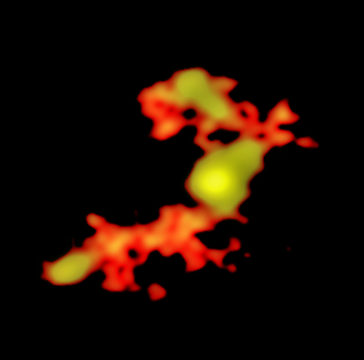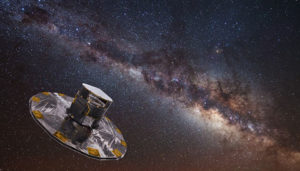In astronomy news last week: The most luminous known quasar is devouring three galaxy companions, while a newly discovered ghostly satellite of the Milky Way hints at hordes more just waiting to be found.
A Hungry Hot DOG on the Far Side of the Universe

T. Diaz-Santos et al., 2018 / N. Lira / ALMA / ESO / NAOJ / NRAO
The most luminous known galaxy in the universe appears to be feeding the gargantuan black hole at its center by cannibalizing three neighboring galaxies, researchers report in the November 16th Science. This find supports the idea that galactic collisions drive the powerful radiation emanating from the cores of some remote galaxies.
During the first 3 billion years after the Big Bang, there lived a population of galaxies colloquially known as Hot DOGs — for hot, dust-obscured galaxies. These galaxies host quasars, brilliant fountains of radiation most likely powered by material falling onto supermassive black holes. Astronomers suspect that the most likely thing capable of feeding these voracious appetites is . . . other galaxies. Collisions between galaxies in the early universe could funnel gas and dust toward these black holes, but evidence for this has been largely circumstantial.
Looking for answers, Tanio Díaz-Santos (Diego Portales University, Chile) and colleagues pointed the radio dishes of the Atacama Large Millimeter/submillimeter Array (ALMA) in Chile toward a galaxy designated WISE J224607.57−052635.0 (or W2246, for short). This galaxy blazes with the light of 350 trillion Suns, light that has taken over 12 billion years to reach Earth.
The ALMA observations reveal rivers of dust streaming on to W2246 from three previously known nearby galaxies. One of the streams spans more than 110,000 light-years. The dusty tentacles connecting W2246 to its neighbors indicate that the galaxies are in the process of merging. Díaz-Santos and co-authors argue that this triple merger is what’s ultimately responsible for powering this quasar. The influx of material could be enough to power and obscure the central supermassive black hole. And if W2246 is typical of other Hot DOGs, the researchers say, then perhaps all ultraluminous quasars in the early universe are powered by galaxies stripping each other for parts.
Reference:
T. Díaz-Santos et al. "The Multiple Merger Assembly of a Hyperluminous Obscured Quasar at Redshift 4.6." Science. November 16, 2018.
Ghostly Galaxy Orbits the Milky Way

ESA / ATG medialab; background: ESO / S. Brunier
A ghost of a galaxy has been lurking on the far side of the Milky Way, hiding this whole time behind the wall of stars that constitutes the disk of our galaxy.
Dubbed Antlia 2, this satellite of the Milky Way is an oddball. It’s either too faint for its size, or too large for its brightness — and it may hint at a whole population of tenuous dwarf galaxies around the Milky Way that have yet to reveal themselves.
Gabriel Torrealba (Academia Sinica, Taiwan) and colleagues discovered Antlia 2 while sifting through the most recent data from the European Gaia satellite, which is spending five years charting the positions and speeds of over a billion stars in and around our galaxy.
In the faint southern constellation Antlia (the “air pump”), mixed in with the dense thicket of stars that marks the plane of the Milky Way, the team found a bunch of RR Lyrae stars, variable stars that are excellent yardsticks for measuring cosmic distances thanks to a strong correlation between their intrinsic brightness and the period of their variability. Moving together across the sky, those pulsating stars were the signpost of an unknown dwarf galaxy almost as large as the Large Magellanic Cloud — the biggest known satellite of the Milky Way — and yet about 4,000 times as faint. The researchers report their findings November 9th on the astronomy preprint arXiv.

Torrealba et al. 2018
Antlia 2 sits about 420,000 light-years away and spans nearly 10,000 light-years. It’s also exceptionally faint — its surface brightness of 32.3 magnitudes per square arcsecond is the lowest known among dwarf galaxies. Estimates of the galaxy’s mass indicate that Antlia 2 lies within a halo of dark matter about 1 billion times as massive as the Sun. That’s in line with other dwarfs that have similar luminosities but is shockingly small given the galaxy’s size.
The Milky Way itself might be partly to blame. Our galaxy’s gravity could be stripping material from Antlia 2, the researchers say, which would explain the dwarf’s low mass. However, it doesn’t explain the puffed up size — galaxies tend to get smaller when they’re cannibalized, not larger. Torrealba and company speculate that an earlier episode of supernovae and powerful winds from massive stars could have inflated Antlia 2. If all of this is true, then there should be cosmic debris scattered around the galaxy, which further observations could uncover.
Editor's Note: This story was updated on November 20th to correct the spelling of Antlia throughout (thanks to eagle-eyed reader Anthony Barreiro for catching this).
Reference:
G. Torrealba et al. “The Hidden Giant: Discovery of an Enormous Galactic Dwarf Satellite in Gaia DR2.” arXiv.org. November 9, 2018.
 3
3









Comments
Anthony Barreiro
November 20, 2018 at 3:01 pm
The constellation is Antlia, not Antila, and the dwarf galaxy is therefore Antlia 2.
Ian Ridpath's "Star Tales" web page on Antlia, linked in this article, contains this paragraph:
"There are no legends associated with Antlia. Its brightest star, Alpha Antliae, is only of fourth magnitude and it contains no objects of note. Its name, however, is one to catch the unwary as it is frequently mis-spelled ‘Antila’."
You must be logged in to post a comment.
Christopher CrockettPost Author
November 20, 2018 at 6:38 pm
Good eye! Thank you -- the story has been corrected. Ian Ridpath would be ashamed. 🙂
You must be logged in to post a comment.
Anthony Barreiro
November 20, 2018 at 7:39 pm
No, I think he would be amused! Antlia is a silly little constellation anyway.
You must be logged in to post a comment.
You must be logged in to post a comment.